Nancy Kelly Allen's Blog, page 4
September 15, 2019
What to Show, Tell, and Omit, Part 1
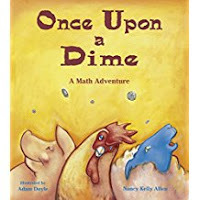 In a recent writing workshop, a participant said she had difficulty knowing what to tell or show in a story and what to leave out. Writers, both experienced and novice, deal with the same problem.
In a recent writing workshop, a participant said she had difficulty knowing what to tell or show in a story and what to leave out. Writers, both experienced and novice, deal with the same problem. Begin a story as late in the plot as possible. Start with the situation, as it is happening, that changes the character’s life. Opening with an action scene is a surefire way to engage the reader. Maybe the action is ambiguous, in order to add suspense or mystery. Or introduce an interesting character that captures the attention of the audience and holds it in a tight grip.
I usually write the first draft without too much concern for voice, focusing on plot, characterization, and conflict. Later, as I revise, I concentrate on voice. At this point, I change much of the telling parts to showing by adding sensory description and details. If I’ve included a block of backstory, I revise to feed it to the audience, bit by bit. Long chunks of backstory slow the action and often becomes boring to the reader, so tread lightly.
In my next blog, I’ll continue with more tips.Call for Submissions for Young Writers:
Amazing Kids E-zine . This educational non-profit publishes work of kids between the ages of 5-13 as well as teens up to the age of 17. To learn more visit their submission guidelines here. They publish a wider variety of work than most traditional journals and are interested in non-fiction, fiction, poems, videos, reviews, and more.
Submission guidelines at http://mag.amazing-kids.org/get-invol...
Call for Submissions for Adult Writers:Chicken Soup for the Soul. “You Go, Girl!” This call is looking for true stories designed to help young women feel stronger, more capable, and more confident. Limit 1,200 words. Payment is $200 and ten copies of the anthology that contains your story. Deadline December 15, 2019.Submissions guidelines at https://www.chickensoup.com/story-sub...
Nancy Kelly Allen has written 50+ children’s books and a cookbook, SPIRIT OF KENTUCKY: BOURBON COOKBOOK.
Comment or check out the blog at https://nancykellyallen.blogspot.com/
Published on September 15, 2019 08:01
September 1, 2019
Writing with a Slant, Part 2
Narrowing a topic and choosing an audience are two factors to consider in writing with a slant. Both were discussed in the previous blog. Two additional factors include:
Researching a topic. When writing AMAZING GRACE, I set aside time to explore books and websites on the Kentucky home front during World War II. Collecting tidbits of information, much more than I’d ever need, provided me with the luxury of sifting out the truths and proofs that worked best for my story setting and age group. Yes, fiction must include accurate facts. Historical fiction comes alive through details.
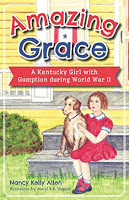 Simple items, such as Kool-Aid, needed to be researched. What flavors were available during the early 1940s? Was a radio station in operation in Ashland, Kentucky, during 1942? I began the story with a family moving from Ashland to Hazard, but further research led me to realize Hazard had no radio station at that time. Ashland did, so the family moved from Hazard to Ashland. Details, small details, make a difference in the believability of a story.
Simple items, such as Kool-Aid, needed to be researched. What flavors were available during the early 1940s? Was a radio station in operation in Ashland, Kentucky, during 1942? I began the story with a family moving from Ashland to Hazard, but further research led me to realize Hazard had no radio station at that time. Ashland did, so the family moved from Hazard to Ashland. Details, small details, make a difference in the believability of a story.Voice. What type of voice should I use? I didn’t want the story to sound frivolous, too carefree. The times were difficult for those on the home front during the war, so I wanted the tone of the book to reflect that, but without burdening the reader with morose nuances. The main character, a young girl named Grace, tells the story and hits a balance between reality and a child-like view that infused a humorous touch.
Writing for a particular audience with a particular slant or particular angle can narrow your story to a perfect fit.
Call for Submissions for Young Writers:
Blue Marble Review. Are you age 13 to 21? (Or do you have writing kids?) If so, then Blue Marble Review is worth considering since there are few paying markets for teen writers. They accept fiction, nonfiction, poetry, and art. Pay is $25 ($75 for cover art). All submissions should be unpublished.Submission guidelines at https://bluemarblereview.com/submit/
Call for Submissions for Adult Writers:
Fun For Kidz magazine looks for activities that deal with timeless topics, such as pets, nature, hobbies, science, games, sports, careers, simple cooking, and anything else likely to interest a child. Each issue revolves around a theme.
Submissions guidelines at https://www.freelancewriting.com/writ...
Nancy Kelly Allen has written 50+ children’s books and a cookbook, SPIRIT OF KENTUCKY: BOURBON COOKBOOK.
Comment or check out the blog at https://nancykellyallen.blogspot.com/
Published on September 01, 2019 06:14
August 18, 2019
Writing with a Slant
When I begin a fictional manuscript, I think about the character, plot, and setting, but I also consider the slants. By slant, I mean writing with an angle, such as:
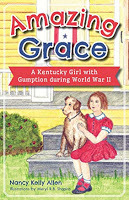 Narrowing the topic. Amazing Grace, a middle grade novel, is a fictional account of American life during World War II. The landscape of the early 1940s is so broad, I narrowed the setting to one small town, Ashland, Kentucky. Rather than covering the entire war years, I focused on one. The book is about 33,000 words, so I was limited in both time and space. Narrowing the topic was a must.
Narrowing the topic. Amazing Grace, a middle grade novel, is a fictional account of American life during World War II. The landscape of the early 1940s is so broad, I narrowed the setting to one small town, Ashland, Kentucky. Rather than covering the entire war years, I focused on one. The book is about 33,000 words, so I was limited in both time and space. Narrowing the topic was a must.Choosing the audience. What age group do I want to reach? I began the Amazing Grace manuscript as a picture book. After many rewrites and revisions, an editor suggested that I rewrite the story for an older audience. After weeks of planning and plotting the story mentally, I started over with middle grade readers in mind. What could my readers handle? What would they enjoy reading and learning? Those were questions that I asked before writing a word.
In my next blog, I’ll address the next two factors for writing with a slant.
Call for Submissions for Adult Writers:
The Caterpillar. This is a respected literary journal for kids between the ages of 8 and 11 accepts submissions of poetry and fiction.
Submissions guidelines at http://www.thecaterpillarmagazine.com...
Nancy Kelly Allen has written 40+ children’s books and a cookbook, SPIRIT OF KENTUCKY: BOURBON COOKBOOK.
Leave a message or check out my blog at www.nancykellyallen.com
Published on August 18, 2019 06:18
August 4, 2019
I’ve Finished My Manuscript, Now What? Part 3
After compiling a list of 15-20 potential publishers that fit the type of manuscript you’ve written, trim the list to the top 5 and submit to those. Before subbing a story, always check the publisher’s/agent’s website to make sure the submission guidelines still accept unsolicited manuscripts.
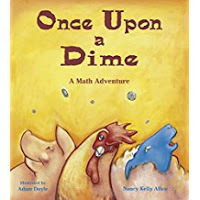 Follow the guidelines exactly. Some have specific information required in the cover letter (such as, three comparable titles in the last three years) and in the number of pages to send. Some want the pages in the body of the email; others prefer an attachment. And some are specific in the information listed on the Subject line of the email. Still, others require manuscripts to be sent by the U. S. Postal Service. Each publisher is different, so check the submission guidelines carefully.
Follow the guidelines exactly. Some have specific information required in the cover letter (such as, three comparable titles in the last three years) and in the number of pages to send. Some want the pages in the body of the email; others prefer an attachment. And some are specific in the information listed on the Subject line of the email. Still, others require manuscripts to be sent by the U. S. Postal Service. Each publisher is different, so check the submission guidelines carefully. Some editors/agents may provide comments on what does or does not work with the manuscript. Take the information and use it (if you agree) to revise the piece. Some editors/agents may suggest the changes and offer and R & R (revise and resubmit). Some may not offer the opportunity to resubmit. Don’t resubmit the manuscript unless the editor/agent requests it. Spend time revising and submit to the next 5 potential publishers on your list. By this time you may have made changes that will make the manuscript more appealing and marketable.
Call for Submissions for Adult Writers:
Youth Imagination is interested in creative fiction stories by teens as well as by adult authors. Make the stories awesome, inspiring and engaging. Our goal is to publish the best writing for and by teens. We particularly love stories exploring their issues, such as bullying, drugs, romance, school, parental issues, teacher issues, etc., as well as about the grit and character of teens and young adults.We accept most genres of fiction, including modern, urban or classical fantasy, as well as sci-fi, slipstream, literary, action-adventure or suspense.Submission guidelines at https://silverblade.submittable.com/submit/17178/youth-imagination
Nancy Kelly Allen has written 50+ children’s books and a cookbook, SPIRIT OF KENTUCKY: BOURBON COOKBOOK. Comment or check out the blog at https://nancykellyallen.blogspot.com/
Published on August 04, 2019 05:50
July 14, 2019
I’ve Finished My Manuscript, Now What? Part 2
Finding a market for a manuscript is as labor intensive as writing it. Once the story is polished, go to your local bookstore/library and look at books in the same genre geared toward the same age group as your manuscript. Check out the publisher. Does it match those on your list? If not, add to your list. Check out the Acknowledgement Page. The editor is sometimes listed there, and sometimes at the end of the book.
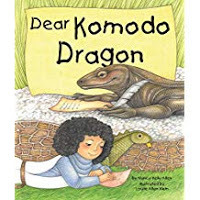 Look at publishers’ catalogs. You can find them on their websites. Do the books seem to be similar to the manuscript you wrote, but different enough to not compete with books in the catalog? If you’re going the agent route, study the type of books s/he represents.
Look at publishers’ catalogs. You can find them on their websites. Do the books seem to be similar to the manuscript you wrote, but different enough to not compete with books in the catalog? If you’re going the agent route, study the type of books s/he represents.At this point look at books listing editors and/or agents, and make a list of approximately 15-20 that seem to be a good fit. Turn to your trusty computer and research the editors/agents’ names. Look for interviews to determine the type of manuscripts they are interested in, the subjects they want to publish (some may state they would love to see a fiction story about a rescue animal or a specific request such as that), and whether they accept unsolicited manuscripts.
Read industry resources. Children’s Bookshelf is free. Some editors and agents participate in MSWL (Manuscript Wish List) at http://www.manuscriptwishlist.com/.
Attend conferences and writing workshops to learn about publishers, editors, and agents. Conferences are helpful in networking with other writers and finding qualified critique partners, who are knowledgeable about writing for children.
In my next blog, I’ll continue with more tips on marketing a manuscript.
Call for Submissions for Adult Writers:
DIG (Into History) is where world history and archaeology meet for kids ages 9 to 14, though adults have been known to find it an interesting read, as well! Each issue of DIG focuses on providing comprehensive coverage of a single theme, allowing children to get in-depth information on historical topics and archaeological discoveries from writers who are experts in the field. With nearly 60 ad-free pages in each issue, DIG provides an adventurous trek through the past that will entertain and educate any young history buff or budding Indiana Jones.Submission guidelines at http://cricketmedia.com/dig-submissio...
Nancy Kelly Allen has written 50+ children’s books and a cookbook, SPIRIT OF KENTUCKY: BOURBON COOKBOOK. Check out her blog at www.nancykellyallen.com
Published on July 14, 2019 07:26
June 23, 2019
I’ve Finished My Manuscript, Now What? Part 1
A few times each month, beginning writers contact me asking for directions, primarily, what to do after they finish their manuscripts. First of all, congratulations are in order. Finishing a manuscript is no small task.
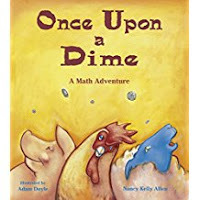 My initial reaction is to advise the writers to do nothing with the manuscript for a month or so, and in the meantime, begin another writing project and find a critique partner to read the manuscript and offer feedback.
My initial reaction is to advise the writers to do nothing with the manuscript for a month or so, and in the meantime, begin another writing project and find a critique partner to read the manuscript and offer feedback.After revising the manuscript and polishing it, make a submission list of appropriate publishers. If a publisher doesn’t accept unsolicited manuscripts or accepts only middle grade and young adult, sending a picture book will garner nothing but a rejection. The goal is to submit to a particular editor or agent. Writers need an individual who will love the work and promote it within the publishing house or literary agency.
Editors and what they are looking for in manuscripts can be found in Children’s Writer’s & Illustrator’s Market, a book that is sold or can be ordered at bookstores or online. Guide to Literary Agents is another source if you choose to go the agent route.
Call for Submissions for Adult Writers:SPIDER, a literary magazine for children, features fresh and engaging literature, poems, articles, and activities for newly independent readers. Editors seek energetic, beautifully crafted submissions with strong “kid appeal” (an elusive yet recognizable quality, often tied to high-interest elements such as humor, adventure, and suspense).
Submission guidelines at http://cricketmedia.com/spider-submis...
Nancy Kelly Allen has written 40+ children’s books and a cookbook, SPIRIT OF KENTUCKY: BOURBON COOKBOOK. Check out her blog at www.nancykellyallen.com
Published on June 23, 2019 06:05
June 9, 2019
Writing Nonfiction
When I decide on a topic for a nonfiction book, I consider three elements: curiosity about a subject, the desire to know more, and the number of published books on the topic. I’ll spend weeks researching facts before I write the first word of the book.
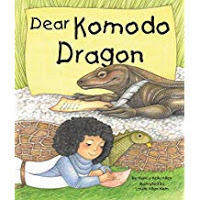 My interest in writing DEAR KOMODO DRAGON began when I visited a zoo and saw “Big Man,” the name given to a ten-foot-long Komodo dragon. I knew nothing about the magnificent creatures, but my interest grew the longer I watched it flick its yellow tongue and maneuver in a clumsy walk. But was my interest enough to spend weeks working on a manuscript that may or may not get published? And how would I present the information in a way that is different than other Komodo dragon books already in the marketplace?
My interest in writing DEAR KOMODO DRAGON began when I visited a zoo and saw “Big Man,” the name given to a ten-foot-long Komodo dragon. I knew nothing about the magnificent creatures, but my interest grew the longer I watched it flick its yellow tongue and maneuver in a clumsy walk. But was my interest enough to spend weeks working on a manuscript that may or may not get published? And how would I present the information in a way that is different than other Komodo dragon books already in the marketplace? I pondered these questions as I wrote other books. One day when I talked with some students who discussed how much they love receiving letters, the Ah-ha moment triggered an idea. I’d present the dragon information in the form of letters, in particular, pen pal letters.
So letters became the structure of the text. For me, deciding how to present the nonfiction information in an interesting way is more difficult than the writing or the research. I love to write, and I love research, but figuring out the structure of the text is never an easy task.
What is the hardest part of writing nonfiction for you?
Between May and September, Calls for Submissions for Young Writers will cease.
Call for Submissions for Adult Writers:Golden Fleece. For Short Stories, Poetry, Puzzles, Artwork, and Essays:
Please attach your submission to the email and include a short bio and any relevant social media links in the message. The subject line of your message should include the specific project you are pitching to, the title of your piece, and what it is. Submission guidelines at http://www.goldenfleecepress.com/subm...
Nancy Kelly Allen has written 40+ children’s books and a cookbook, SPIRIT OF KENTUCKY: BOURBON COOKBOOK. Check out her blog at www.nancykellyallen.com
Published on June 09, 2019 06:21
May 26, 2019
Becoming and Staying Productive with Writing
We’re ending the fifth month of the year. Back in January, many writers had manuscript ideas popping and cracking as if trying to explode onto paper. The passion was sizzling. But as we write and the sentences don’t flow quickly or in any semblance of rhythm, the flame of passion for writing can cool to an ember, if that.
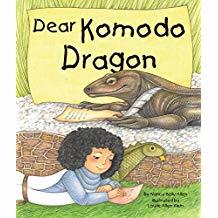 This happens to many writers, including me. If it also happens to you, take time to figure out why you’re writing. Do you have an appetite for storytelling? Do you write because you love it? If so, the words will come. Perseverance leads to success. Along the way, you face heartbreaking moments, those times when you KNOW, you are certain the editor will contact you with great news because you’ve been exchanging emails and phone calls; then the unbelievable happens. After all those rewrites and time and anxious moments, you receive a rejection. Pain as real as a punch shoots clear to the heart and hammers it.
This happens to many writers, including me. If it also happens to you, take time to figure out why you’re writing. Do you have an appetite for storytelling? Do you write because you love it? If so, the words will come. Perseverance leads to success. Along the way, you face heartbreaking moments, those times when you KNOW, you are certain the editor will contact you with great news because you’ve been exchanging emails and phone calls; then the unbelievable happens. After all those rewrites and time and anxious moments, you receive a rejection. Pain as real as a punch shoots clear to the heart and hammers it.Perseverance also brings joyful surprises. You may have sent out a manuscript so long ago, you simply forgot about it and gave up hope. Then out of the blue, an editor contacts you with a YES.
The day-to-day writing schedule can be more hum-drum than kicking-up-heels exciting, but those moments when your writing connects with an editor or a fan contacts you stating that your book, your literary baby, was her favorite, takes the mere ordinary into the extraordinary stratosphere. That’s the magic of writing, the magic that fires a writer’s passion to produce more and better storytelling.
Persevere and you will find success in writing. Persevere and experience the magic.
Call for Submissions for Young Writers:
Skipping Stones. Writings (essays, stories, letters to the editor, riddles and proverbs, etc.) should be typed or neatly handwritten and limited to 1,000 words and poems to 30 lines. We encourage writings in all languages with an English translation, if possible. And, we love illustrations! Please send originals of your drawings, paintings, or photos to our post office box address below. Include your name, age, and address along with your submission.
Submission guidelines at http://www.skippingstones.org/submiss...
Since schools are dismissing for summer, I’ll discontinue Call for Submissions for Young writers until September.
Call for Submissions for Adult Writers:
Skipping Stones. Our readers, ages 7 to 17, hail from diverse cultural and socioeconomic backgrounds. We want to make their reading of Skipping Stones an active experience, relevant to issues confronting them locally and globally. Writing and artwork by adults should challenge readers to think, learn, cooperate and create.
We encourage adults to submit creative informational stories rather than pure fiction. We prefer submissions focusing on your own culture or experiences. No adult poetry, please.
Submission guidelines at http://www.skippingstones.org/submissions.htm#adult
I’ll resume Call for Submissions for Young Writers in September.
Nancy Kelly Allen has written 50+ children’s books and a cookbook, SPIRIT OF KENTUCKY: BOURBON COOKBOOK. Check out her blog at www.nancykellyallen.com
Published on May 26, 2019 06:28
May 12, 2019
Writing to an Audience
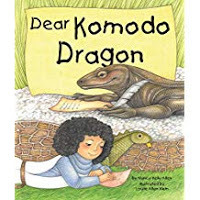 With each writing class I teach, one element always surfaces with novice writers. In various ways they express the same idea: I thought writing for children would be easier than it is.
With each writing class I teach, one element always surfaces with novice writers. In various ways they express the same idea: I thought writing for children would be easier than it is. Today’s children’s books are sophisticated and creative. The storyline encourages readers to imagine a world or event they’d never thought of. In addition, the story should not be so complex the reader has difficulty following the plot. Neither should it be so simple it bores them. A worthwhile story challenges the reader to think, imagine, and ask questions to learn more.
Readers of all ages are discerning critics. If a child does not like the book, he/she will not read it. Knowing your audience is critical to writing a book that appeals. Children ages 3 and up, like rhyme. Lots of rhyming books are available for children younger than three, but the rhyming aspect will be lost on most.
Many children ages 5-6 concentrate for about 10-15 minutes on a single activity. Those who are 7-8 can concentrate about 30 minutes, but they must be engaged in the story to do so.
Understanding your audience and writing to that audience can benefit writers. Writing clear and understandable text with compelling characters and interesting plots engages readers of any age.
Call for Submissions for Young Writers:
Submissions guidelines at http://www.haikubytwo.com/berry-blue-...
Call for Submissions for Adult Writers:
Berry Blue Haiku. Although the magazine is dedicated to kids, it’s also targeted toward teachers and parents who have an interest in or want to learn about haiku. We’ll be featuring articles and lessons on writing haiku that can be used both at home and in the classrooms. We want the magazine to inspire young and old alike.
Submissions guidelines at http://www.haikubytwo.com/berry-blue-...
Nancy Kelly Allen has written 40+ children’s books and a cookbook, SPIRIT OF KENTUCKY: BOURBON COOKBOOK.
Leave a message or check out my blog at www.nancykellyallen.com
Published on May 12, 2019 06:39
April 21, 2019
“Write” Start: Question
Today’s blog concludes the series, “Write” Start.
When opening a story with a question, the reader should feel the need to look for an answer, and the only way to discover the answer is to continue reading.
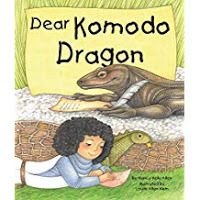 Charlotte’s Web begins with the question, “Where’s Papa going with that ax?” Those six, gripping words have intrigued generations of readers. A good hook creates interest and also sets the tone, mood, and builds expectations for the reader. From the first sentence, the reader wants to know what is going to happen.
Charlotte’s Web begins with the question, “Where’s Papa going with that ax?” Those six, gripping words have intrigued generations of readers. A good hook creates interest and also sets the tone, mood, and builds expectations for the reader. From the first sentence, the reader wants to know what is going to happen.Using a question as an opening hook works for fiction and nonfiction. In my Rock It series, I used this as the beginning text:” Can one type of rock change into another?”
The question doesn’t have to be answered immediately. Unanswered questions keep the tension high and hold the readers’ interest. Plus, the initial hook buys the writer some time to use quality writing to keep the reader turning the pages.
Hooks can take the reader into a state of wonder and pique their inquisitiveness. Decide what your audience is interested in and write accordingly. Consider what details or moments would spark their interests, and begin there.
Call for Submissions for Young Writers:
Cyberkids. Would you like to have a story, poem, article, picture or other creative work published in Cyberkids? To submit your work, email it to: editor@cyberkids.com . In the email, tell us your name, age and country. If you are sending artwork, save the art in JPEG or TIFF format if possible, and attach it to the email. We do not pay for submissions, but if we use your work, we will send you an email telling you when it will be published.
Submission Guidelines
Here are some guidelines our editors use to decide what to publish:
We especially like stories, articles and poems that are funny.Art and written submissions can be on any topic that is appropriate for our audience (ages 7 to 12).Stories which include an original illustration or photo are more likely to be published than stories without pictures.Originality is very important--make sure the work you submit is your own and not copied from someone else.In addition to art and writing, we also like to publish games, puzzles, brain teasers, jokes, and multimedia creations by kids. Submissions guidelines at http://www.cyberkids.com/he/html/subm...
Call for Submissions for Adult Writers:
Fun for Kidz. We are looking for lively writing that involves an activity that is both wholesome and unusual. The Ideal length of a FUN FOR KIDZ nonfiction piece is up to 300-325 words for a one-page magazine article or up to 600-650 words for a two-page magazine article. Articles that are accompanied by strong high-resolution photos are far more likely to be accepted than those requiring illustration.
Submissions guidelines at http://funforkidzmagazines.com/writers
Nancy Kelly Allen has written 40+ children’s books and a cookbook, SPIRIT OF KENTUCKY: BOURBON COOKBOOK.
Leave a message or check out my blog at www.nancykellyallen.com
Published on April 21, 2019 06:55



